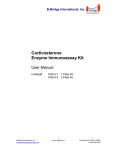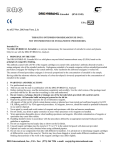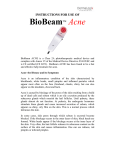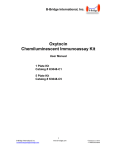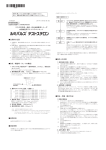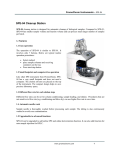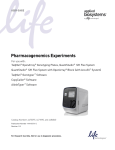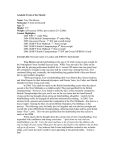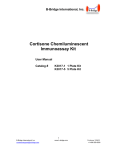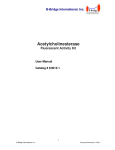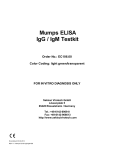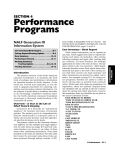Download User Manual - B-Bridge International, Inc.
Transcript
B-Bridge International, Inc. Dehydroepiandrosterone sulfate (DHEA-S) ELISA Kit User Manual Catalog # K3054-1 K3054-5 1 Plate 5 Plates 1 B-Bridge International, Inc. [email protected] www.b-bridge.com DHEA-S 150902 +1-408-252-6200 TABLE OF CONTENTS Intended Use 3 Background 3 Assay Principle 4 Kit Components 4 Materials Required 4 Precautions 5 Reagent Preparation 5 Sample Preparation 6 Assay Protocol 7 Calculations 7 Typical Data 8 Typical Standard Curve 8 Notice to Purchaser This product is to be used for Research Purposes Only. It is not to be used for Drug or Diagnostic Purposes, nor is it intended for Human Use. B-Bridge products may not be resold, modified for resale, or used to manufacture commercial products without the express written consent of B-Bridge International, Inc. EXCEPT AS OTHERWISE EXPRESSLY SET FORTH IN THIS USER MANUAL, B-BRIDGE DOES NOT MAKE ANY REPRESENTATION OR WARRANTIES OR CONDITIONS OF ANY KIND, EITHER EXPRESSED OR IMPLIED, WITH RESPECT TO THE PRODUCTS, OR INFORMATION DISCLOSED HEREUNDER, INCLUDING, BUT NOT LIMITED TO, THE IMPLIED WARRANTIES OF MERCHANTABILITY, FIT FOR A PARTICULAR PURPOSE, OR NONINFRINGEMENT OF THE INTELLECTUAL PROPERTY RIGHTS OF THIRD PARTIES. B-Bridge International, Inc. All Rights Reserved. 2 B-Bridge International, Inc. [email protected] www.b-bridge.com DHEA-S 150902 +1-408-252-6200 INTENDED USE B-Bridge’s Dehydroepiandrosterone sulfate Immunoassay kit uses a specifically generated antibody to measure Dehydroepiandrosterone sulfate (DHEA-S) in serum, plasma, urine, and saliva samples, and in fecal extracts. The kit will also quantitatively measure DHEA-S present in tissue culture media samples. DHEA-S is species independent. BACKGROUND Dehydroepiandrosterone sulfate, C19H28O5S, (5-androsten-3ß, 16a-diol-17-one sulfate, DHEA-S) is the major C19 steroid secreted by the adrenal cortex, and is a precursor in testosterone and estrogen biosynthesis. It is produced by the addition of a sulfate group to dehydroepiandrosterone (DHEA), catalyzed by the sulfotransferase enzymes, SULT1A1 and SULT1E1, which also produce estrone sulfate from estrone. DHEA sulfate can also be back-converted to DHEA through the action of steroid sulfatase. Due to the 17-ketone group rather than hydroxyl group, DHEA-S has relatively low androgenic activity (1). However the bioactivity of DHEA-S may be high due to its high serum concentrations at 100-1,000-fold higher than testosterone or DHEA and its weak affinity for sex-hormone binding globulin (2). Dehydroepiandrosterone sulfate The physiological role of DHEA-S is not well defined with serum levels being high in the fetus and neonates, low during childhood and increased during puberty (3, 4). DHEA-S levels decline during the third decade of life (5). DHEA-S, unlike DHEA and other steroids, does not show a significant diurnal or day-to-day variation. DHEA-S levels are not increased due to ACTH administration and do not change significantly during the normal menstrual cycle (2, 4). DHEA-S has a lower metabolic clearance rate than DHEA (6). Since DHEA-S is primarily produced by the adrenal glands, it is useful as a marker for adrenal function. Adrenal tumors, cancers, and hyperplasia can lead to the overproduction of DHEA-S. While elevated levels may not be noticed in adult men, they can lead to amenorrhea and visible symptoms of virilization. These changes vary in severity and may include: a deeper voice, hirsutism, male pattern baldness, muscularity, acne and enlargement of the Adam’s apple. Women with polycystic ovary syndrome tend to have elevated levels of DHEA-S. Excess levels of DHEA-S in children can cause precocious puberty in boys; and ambiguous external genitalia, excess body hair, and abnormal menstrual periods in girls. 1. Dorfman RI, Shipley, RA., Androgens, J. Wiley and Sons, NY, 1956, 116-128. 2. Pang S. and Riddick, L, In: “Pediatric Endocrinology, A Clinical Guide, 2nd Ed.”. F. Lifshitz (Ed.) 1990, Marcel Dekker, Inc. New York, 259-291. 3. de Peretti E, Forest MG., “Pattern of plasma dehydroepiandrosterone sulfate levels in humans from birth to adulthood: evidence for testicular production”. 1978, J. Clin. Endocrinol. Metab. 47:572-577. 4. Lashansky, G., et. al., “Normative data for adrenal steroidogenesis in a healthy pediatric population: ageand sexrelated changes after adrenocorticotropin stimulation”. 1991, J. Clin. Endocrinol. Metab. 73:674-686. 5. Zumoff, B., et. al., “Sex differences in the twenty-four-hour mean plasma concentrations of dehydroisoandroster one (DHA) and dehydroisoandrosterone sulfate (DHAS) and the DHA to DHAS ratio in normal adults”. 1980, J. Clin. Endocrinol. Metab. 51:330-333. 6. Pang S., “Late-onset adrenal steroid 3 beta-hydroxysteroid dehydrogenase deficiency. I. A cause of hirsutism in pubertal and postpubertal women”. 1985, J. Clin. Endocrinol. Metab. 60:428-39. 3 B-Bridge International, Inc. [email protected] www.b-bridge.com DHEA-S 150902 +1-408-252-6200 ASSAY PRINCIPLE A DHEAS standard is provided to generate a standard curve for the assay and all samples should be read off the standard curve. Standards or diluted samples are pipetted into a clear microtiter plate coated with an antibody to capture sheep antibodies. A DHEA-S-peroxidase conjugate is added to the standards and samples in the wells. The binding reaction is initiated by the addition of a polyclonal antibody to DHEA-S to each well. After 2 hours incubation, the plate is washed and substrate is added. The substrate reacts with the bound DHEA-S-peroxidase conjugate. After a short incubation, the reaction is stopped and the intensity of the generated color is detected in a microtiter plate reader capable of measuring 450nm wavelength. The concentration of the Dehydroepiandrosterone sulfate in the sample is calculated, after making suitable correction for the dilution of the sample, using software available with most plate readers. KIT COMPONENTS K3054-1 1 plate K3054-5 5 plates DHEA-S Standard (1,200 ng/ml) in stabilizing solution 70 µl 350 µl DHEA-S Antibody Sheep polyclonal antibody specific for DHEA-S 3 ml 13 ml DHEA-S Conjugate DHEA-S–peroxidase conjugate in stabilizing solution 3 ml 13 ml 5x Assay Buffer 28 ml 55 ml 20x Wash Buffer 30 ml 125 ml TMB Substrate 11 ml 55 ml Stop Solution 1M hydrochloric acid solution 5 ml 25 ml Plate sealer 1 each 5 each Clear 96 well Plate Coated with donkey anti-sheep IgG Store above components at 4°C MATERIALS REQUIRED BUT NOT SUPPLIED Distilled or deionized water Colorimetric 96-well microplate reader capable of reading OD at 450 nm Software for converting raw relative optical density readings from the plate reader and carrying out four parameter logistic curve (4PLC) fitting. Repeater or multi-channel pipet Timer ACS grade ethanol or ethyl acetate, glass test tubes, shaker, speedvac, centrifuge for extraction of dried fecal samples For saliva samples – 15 ml centrifuge tubes, centrifuge 4 B-Bridge International, Inc. [email protected] www.b-bridge.com DHEA-S 150902 +1-408-252-6200 PRECAUTIONS As with all such products, this kit should only be used by qualified personnel who have had laboratory safety instruction. The complete insert should be read and understood before attempting to use the product. The antibody coated plate needs to be stored desiccated. The silica gel pack included in the foil ziploc bag will keep the plate dry. The silica gel pack will turn from blue to pink if the ziploc has not been closed properly. This kit utilizes a peroxidase-based readout system. Buffers, including other manufacturers Wash Buffers, containing sodium azide will inhibit color production from the enzyme. Make sure all buffers used for samples are azide free. Ensure that any plate washing system is rinsed well with deionized water prior to using the supplied Wash Buffer. The Stop Solution is acid. The solution should not come in contact with skin or eyes. Take appropriate precautions when handling this reagent. In all cases, please consult your institution’s safety procedures for working with hazardous chemicals. REAGENT PREPARATION Allow the kit reagents to come to room temperature for 30 minutes. Standards should be run in duplicate for accurate determination of DHEA-S concentrations. Assay Buffer Dilute the 5x Assay Buffer 1:5 by adding 1 part buffer with 4 parts deionized water. The 1x Assay Buffer is stable for 3 months at 4°C. Wash Buffer Dilute the 20x Wash Buffer 1:20 by adding 1 part buffer with 19 parts deionized water. The 1x Wash Buffer is stable for 3 months at room temperature. Standard Preparation Use all Standards within 2 hours of preparation. 1. Label tubes #1 through #5. 2. Pipet 380 µl of 1x Assay Buffer into tube #1 and 160 µl into tubes #2 - #5. 3. The DHEA-S stock solution contains an organic solvent. Prerinse the pipet tip several times to ensure accurate delivery. Add 20 µl of the DHEA-S stock solution to tube #1 and vortex completely. 4. Take 40 µl of the DHEA-S solution in tube #1 and add it to tube #2 and vortex completely. Repeat the serial dilution for tubes #3 - #5. 5. The concentration of DHEA-S in tubes 1 through 5 will be 60,000, 12,000, 2,400, 480, and 96 pg/ml. Reagent 1x Assay Buffer DHEA-S Standard Standard 1 Standard 2 Standard 3 Standard 4 Final Concentration (pg/ml) Standard Standard Standard Standard Standard 1 2 3 4 5 380 µl 160 µl 160 µl 160 µl 160 µl 20 µl 40 µl 40 µl 40 µl 40 µl 60,000 12,000 2,400 480 96 5 B-Bridge International, Inc. [email protected] www.b-bridge.com DHEA-S 150902 +1-408-252-6200 SAMPLE PREPARATION Samples should be run in duplicate for accurate measurements. Ensure that all samples have reached room temperature and have been diluted appropriately prior to running the assay. Samples containing visible particulates should be centrifuge prior to use. Serum and Plasma Samples The minimum Assay Buffer dilution for human serum and plasma samples is 1:2, but due to the high sample concentration most samples will have to be diluted at least 1:100 with 1x Assay Buffer. For measurement of DHEA-S in non-human samples it is recommended that the end user carry out a preliminary dilution series to determine the correct dilution for their samples. Urine Samples Urine samples must be diluted at least 1:2 with 1x Assay Buffer, but due to the high sample concentration most samples will have to be diluted at least 1:100 with 1x Assay Buffer. For measurement of DHEA-S in non-human samples it is recommended that the end user carry out a preliminary dilution series to determine the correct dilution for their samples. For comparison to creatinine as a urine volume marker please see our NIST-calibrated 2 and 10 plate Urinary Creatinine Detection kits, K3002-1 and K3002-5. Saliva Samples Whole saliva should be obtained at least 2 h after eating and rinsing mouth with water to avoid any food borne antigens or materials from affecting the analysis. Methods of saliva collection vary widely, it is best to collect saliva by allowing the saliva to passively flow into a 15 mL centrifuge tube. Saliva samples must be diluted at least 1:2 times with 1x Assay Buffer. A saliva clarification protocol, if needed. Store samples frozen at -20°C. Upon thawing, the saliva is centrifuged at 2,500 x g for 20 minutes and the clear supernatant is pipetted off any precipitated material. Samples should be kept on ice, analyze immediately or aliquot and frozen at -20°C (-80°C long term storage). Minimize the number of freeze-thaws cycles to prevent degradation of DHEA-S. Dried Fecal Samples Ensure that the sample is completely dry and powder the sample to improve extraction efficiency. Remove any large particles, such as grass, if possible. We suggest checking the efficiency of extraction by preparing a DHEA-S solution of known concentration in the 1x Assay Buffer. Spike one aliquot of your sample with a volume of the DHEA-S solution in 1x Assay Buffer (Control Spike) and one aliquot of sample with the same volume of only 1x Assay Buffer (Control Sample). Extract samples and both Controls with Ethanol or Ethyl Acetate as described below. 1. Weigh out ≥ 0.2 gm of dried fecal solid into a tube. 2. Add 1 ml of Ethanol (or Ethyl Acetate) for every 0.1 gm of solid. 3. Shake vigorously for at least 30 minutes. 4. Centrifuge samples at 5,000 rpm for 15 minutes. Transfer measured volume of supernatant to a clean tube for evaporation. 5. Evaporate supernatant solution to dryness in a SpeedVac or under nitrogen. Keep dried extracted samples frozen < -20°C in a desiccator. 6. Dissolve extracted sample with 100µl ethanol, followed by at least 400µL 1x Assay Buffer. Vortex well and allow to sit for 5 minutes at room temperature. Vortex and sit for 5 minutes twice more to ensure complete DHEA-S solubility. For immunoassays ethanol content in the well should be below 5%. Dilute the ethanol:Assay Buffer mixture ≥ 1:10 with 1x Assay Buffer. 7. Run reconstituted diluted samples in assay immediately. 6 B-Bridge International, Inc. [email protected] www.b-bridge.com DHEA-S 150902 +1-408-252-6200 8. Determine the extraction efficiency by comparing the concentration of the DHEA-S measured in the extracted Control (Control Spike - Control Sample) with the concentration of DHEA-S before extraction. Note: In step 5 if only a portion of the organic solvent is being evaporated, ensure final amounts of measured DHEA-S per gm solid accounts for volume of solution evaporated. Tissue Culture Media (TCM) Samples For measuring DHEA-S in tissue culture media (TCM), samples should be read off a standard curve generated in TCM. Samples may need to be diluted further in TCM. The assay was validated using RPMI-1640. Use all samples within 2 hours of preparation. ASSAY PROTOCOL Standards and samples should be run in duplicate 1. Determine the number of wells needed and return the unused wells to the foil pouch with desiccant. Seal the ziploc bag and store at 4°C. 2. Pipet 50 µl of samples or standards into wells in the plate. 3. Pipet 75 µl of 1x Assay Buffer into the non-specific binding (NSB) wells. 4. Pipet 50 µl of 1x Assay Buffer into wells to act as maximum binding wells (B0 or 0 ng/ml). 5. Add 25 µl of the DHEA-S Conjugate to each well using a repeater pipet. 6. Add 25 µl of the DHEA-S Antibody to each well, except the NSB wells, using a repeater pipet. 7. Gently tap the sides of the plate to ensure adequate mixing of the reagents. Cover the plate with the plate sealer and shake at room temperature for 2 hour. If the plate is not shaken signals bound will be approximately 20% lower. 8. Aspirate the plate and wash each well 4 times with 300 µl 1x Wash Buffer. Tap the plate dry on clean absorbent towels. 9. Add 100 µl of the TMB Substrate to each well, using a repeater pipet. 10. Incubate the plate at room temperature for 30 minutes without shaking. 11. Add 50 µl of the Stop Solution to each well, using a repeater or a multichannel pipet. 12. Read the optical density generated from each well in a plate reader capable of reading at 450 nm. 13. Use the plate reader’s built-in 4PLC software capabilities to calculate DHEA-S concentration for each sample. CALCULATIONS Average the duplicate OD readings for each standard and sample. Create a standard curve by reducing the data using the 4PLC fitting routine on the plate reader, after subtracting the mean OD’s for the NSB. The sample concentrations obtained, calculated from the %B/B0 curve, should be multiplied by the dilution factor to obtain neat sample values. 7 B-Bridge International, Inc. [email protected] www.b-bridge.com DHEA-S 150902 +1-408-252-6200 Typical Data Always run your own standard curve for calculating results. Do not use this data. Conversion Factor: 100 pg/ml of DHEA-S in equivalent to 256.1 pM TYPICAL STANDARD CURVE Standard curves vary with each assay. Always run your own standard curves for calculation of results; do not use this data 8 B-Bridge International, Inc. [email protected] www.b-bridge.com DHEA-S 150902 +1-408-252-6200








